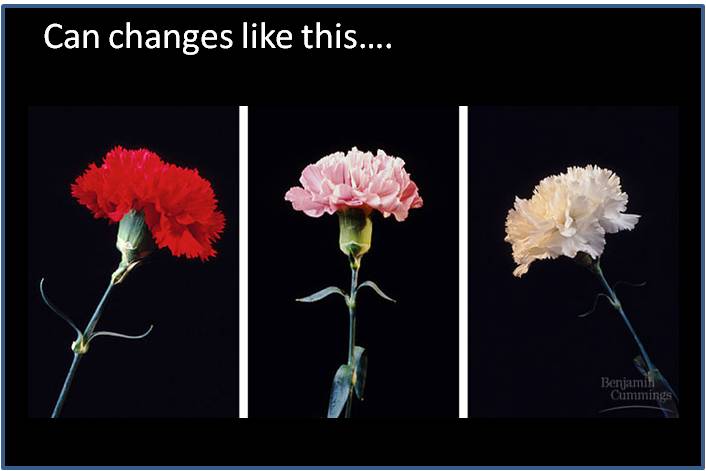
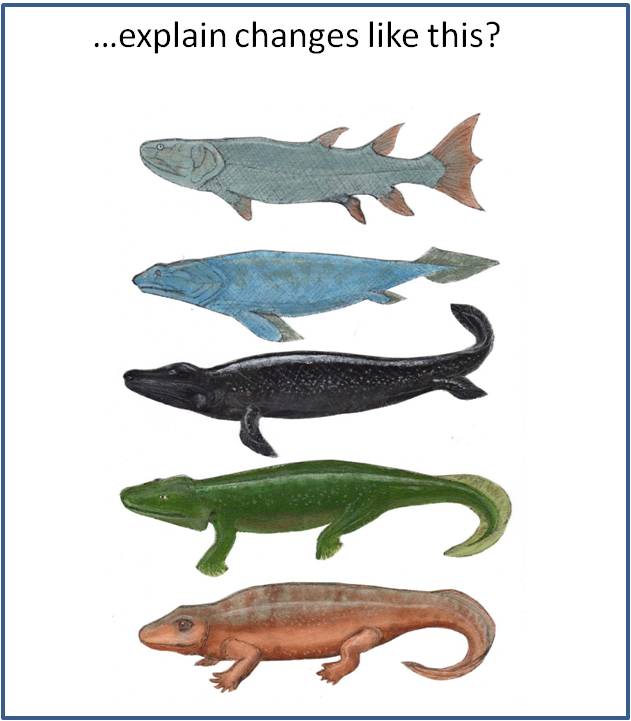
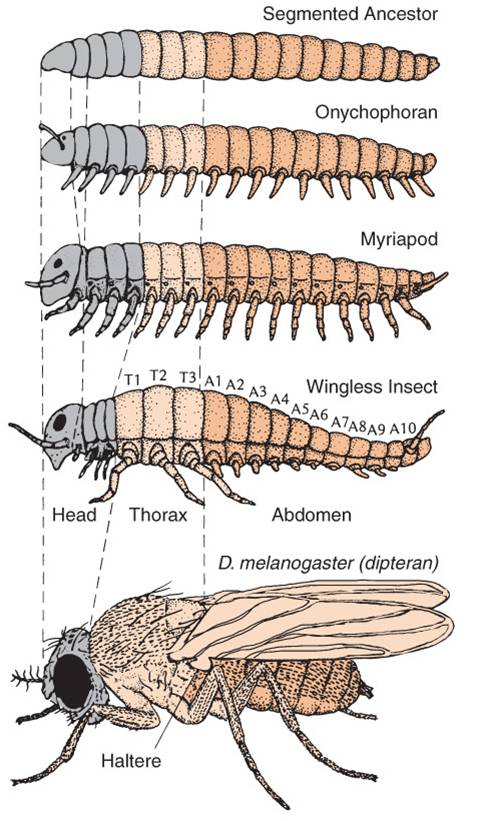
The modern synthesis and population genetics, following on classical Mendelian genetics, tended to focus on evolution as a process that occurred as a consequence of changes in the gene frequencies of structural genes - genes that code for enzymes and structural proteins. And although these protein sequences do vary over evolutionary time, and although many changes in these genes are adaptive responses to the environment, the large scale changes in evolution - like the evolution of legs in the first amphibians or wings in the first birds - seemed to be due to another cause. Why? Because fish and birds are made out of the same proteins as their ancestors (fish and archosaurs, respectively). Subtle changes in the type of collagen protein produced, or the type of hemoglobin produced, could not explain these large scale changes in morphology that are truly the most dramatic patterns in evolution. Evolving a leg from a bony fin is not a function of making a slightly different type of collagen - it is a function of putting the collagen and cells together in a new way, to create a new shape. Indeed, some biologists were so convinced that these processes were fundamentally different that they use the term 'microevolution' to explain differences within a population and 'macroevolution' to explain large scale morphological changes over geologic time.
 |
 |
 |
| Can changes in the frequency of genes that code for different proteins within populations, even if they are adaptive like flower color, explain major differences in body plan? | The structural proteins that make up these organisms are largely the same. The differences seem to be more a function of the way the proteins and cells are put together: the way the organism develops and expresses its morphology. | It turns out that these developmental plans are coordinated by genes, too. So small changes in developmental genes can have large effects on the final shape and characteristics of the organism. |
Ever since the 1800's, embryologists were impressed by the pattern of epigenetic development - the formation of structures by embryos that did not have them in the past. So, how does a frog embryo (like the one below) that does NOT have legs today grow them tomorrow? During the 20th century, some evolutionary biologists suggested that the answer to this question might have a bearing on how legs evolved in the first place... how did fish, which do NOT have legs, evolve into amphibians that DO have legs? Starting in the 1970's, developmental biologists began to identify the genes responsible for these changes in the 'shape' of organisms - genes that influenced how balls of cells (embryos) developed into fish or amphibians, reptiles or birds. And sure enough, the insights gained in how an individual embryo grows legs gave insights into how legs may have evolved. Studying the relationship between evolution and the genes that regulate development became a field in itself: evolutionary development or "evo-devo", for short.
As with the modern synthesis, itself,
the unification of developmental biology and evolutionary biology occurred as
sc ientists, learning new things in their own fields, recognized the relevance
of their work to new areas. Consider the work of Jacob and Monod that we have
already discussed, on the lac operon. Their work showed how genes could be turned
on and off in response to environmental cues. Molecular biologists described
ways that different genes were regulated in different cells: through the action
of repressors and inducers (like transcription factors) that turn transcription
on and off (often in response to external stimuli through signal transduction),
through the differential splicing of m-RNA transcripts, through the differential
splicing of initial protein products, and through the subsequent modification
of those proteins. These are the processes that make cells in an organism different
from one another during organismal development - they make bone tissue different
from skin tissue, for example, and they determine the rate at which these tissues
will grow. They regulate the growth of tissues and organs and the subsequent
shape of an organism - its morphology. Evolutionary biologists and molecular
geneticists realized that these regulatory genes, that influence the co-ordinated
development of tissue specialization in organisms, might be the drivers of major
evolutionary innovations. The second realization was that, because most animals
share a similar embryological development, that these genes that regulate how
development occurs should be largely homologous - even if the pathways that
they regulate lead to the formation of very different (and non-homologous) structures.
ientists, learning new things in their own fields, recognized the relevance
of their work to new areas. Consider the work of Jacob and Monod that we have
already discussed, on the lac operon. Their work showed how genes could be turned
on and off in response to environmental cues. Molecular biologists described
ways that different genes were regulated in different cells: through the action
of repressors and inducers (like transcription factors) that turn transcription
on and off (often in response to external stimuli through signal transduction),
through the differential splicing of m-RNA transcripts, through the differential
splicing of initial protein products, and through the subsequent modification
of those proteins. These are the processes that make cells in an organism different
from one another during organismal development - they make bone tissue different
from skin tissue, for example, and they determine the rate at which these tissues
will grow. They regulate the growth of tissues and organs and the subsequent
shape of an organism - its morphology. Evolutionary biologists and molecular
geneticists realized that these regulatory genes, that influence the co-ordinated
development of tissue specialization in organisms, might be the drivers of major
evolutionary innovations. The second realization was that, because most animals
share a similar embryological development, that these genes that regulate how
development occurs should be largely homologous - even if the pathways that
they regulate lead to the formation of very different (and non-homologous) structures.
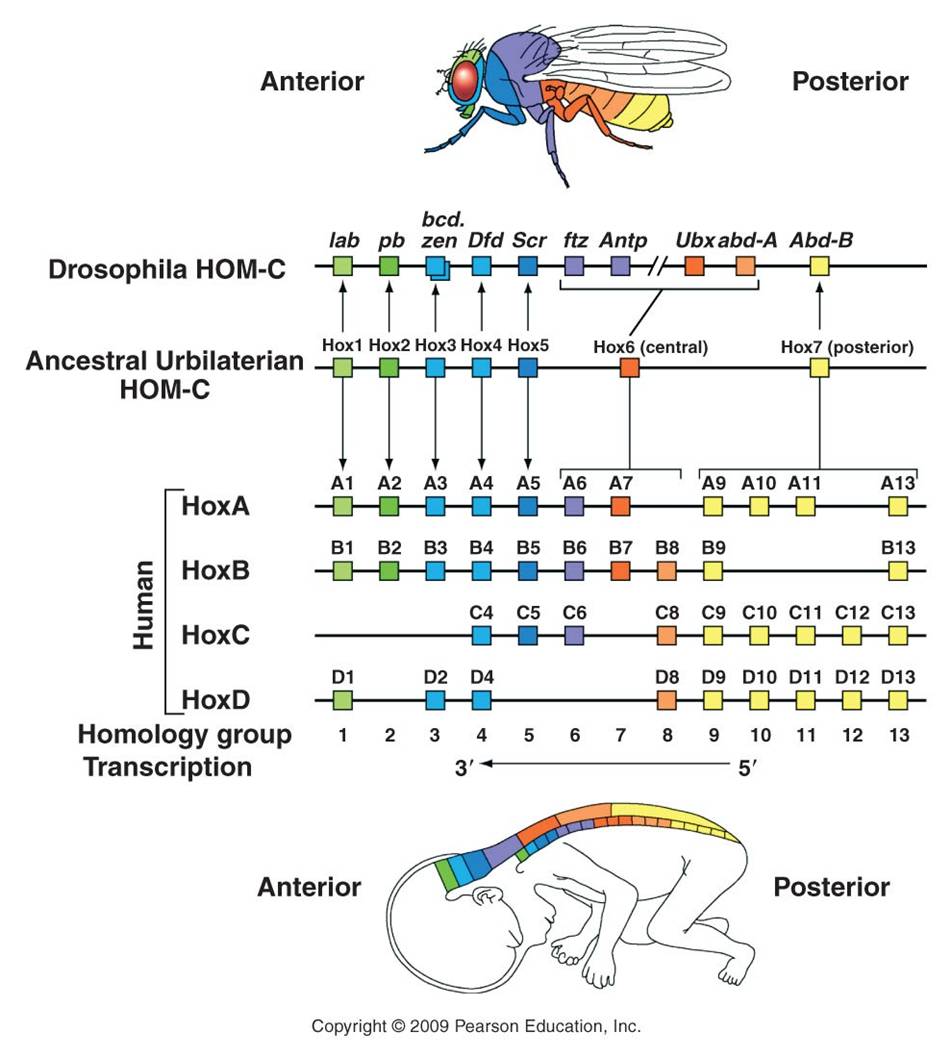 B.
Homeotic Genes
B.
Homeotic GenesAs we will see when we get to animal diversity, almost all animals are 'segmented'. Like the segments on a worm, insect, or vertebrate spinal column, segmentation of body parts allows for specialization of structure and function. Much like gene duplication is a source of genetic novelty (keeping the original function while also allowing for the evolution of something new in the duplicated gene), dividing (or multiplying) the body into segments allows some segments to evolve new function without compromising the ability of the organism to do the 'old stuff', too. In one of the most remarkable and surprizing genetic discoveries of the last 30 years, molecular developmental geneticists were able to decipher how a group of genes act synergistically to coordinate the process of segmentation and subsequent specialization in the developing embryo. Although these genes and their activities were originally described in Drosophila fruit flies, the prediction of homology among animals for the genes regulating these fundamental processes was supported - these genes that regulate segmentation have been found in all segmented animals, from worms to vertebrates. In fact, ancestral homologs to these genes have also been found, in fewer number, in non-segmented Cnidarians (corals, jellyfish, and hydra).
The relationship between gene duplication and segment specialization is even more direct. These homeotic genes that regulate development are very similar to one another, and have undoubtedly arisen by gene duplication. One family of genes all have a very similar sequence that codes for a DNA binding domain (as we would expect for a transcription factor that must bind DNA). This sequence is called a "homeobox", and the genes in this family are called the Hox genes. So, we see the process of duplication occurring at a genetic level, and causing body segment duplication at the organism level, with the same evolutionary consequence of providing the potential for new evolutionary innovation.
Changes in these genes can have profound effects on the final morphology of a segment. And because these genes encode transcription factors that are binding to MANY genes in the same cell, there are correlated and co-ordinated responses among the genes in a cell and the cells in that segment. Consider the "antennapedia" gene in Drosophila. It is "on" in the thoracic segments of a developing fly pupa during metamorphosis. The gene product - a transcription factor - stimulates the production of myriad genes that leads to the development of muscle, nerve, and exoskeleton tissue in the shape of a leg. This gene is normally off in head and abdominal segments, so legs don't develop there. However, mutants occur that express this gene in the head segment that usually gives rise to the antennae. In these individuals, the activation of the gene causes the development of legs on the head - where antennae should be.
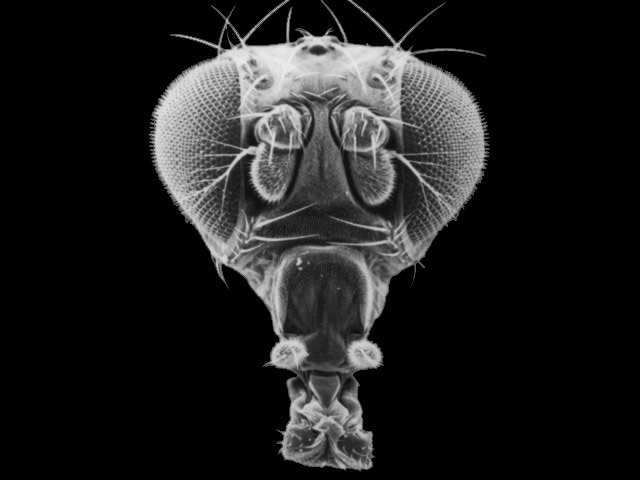 |
 |
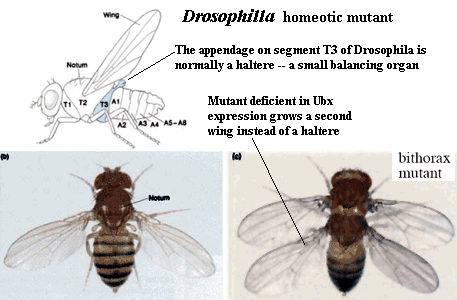 |
| Normal fruit fly, with normal antennae on front of head | Mutant, with legs instead of antennae | The effect of the 'Ultrabithorax' gene, on right. |
Another important hox gene in Drosophila, homologous to antennapedia and next to it (both suggesting that it is a gene duplicate) is the "ultrabithorax" (Ubx) gene. This gene codes for a m-RNA transcript that is spliced 5 different ways, and so is translated into five different transcription factor proteins. Normal expression of Ubx in the third thoracic segment of the fly interrupts development of a wing, and stimulates development of a larger set of legs on the third thoracic segment. Mutation in Ubx in this segment makes this thoracic segment develop like the second thoracic segment, growing wings and a smaller pair of legs.
Vertebrates have homologs of these same homeotic genes, with different numbers of copies of each that have arisen by duplication and deletion in the vertebrate lineage (see the colorful figure, above). Now, vertebrates don't have antennae or membraneous wings. However, these regulatory pathways still exist that turn on different sets of genes in these animals. These homeotic genes are like "genetic switches". Think about an electronic switch - it can flip on an incandescent light, a flourescent light, a blender, or a TV. The key is that the switch is linked to a given circuit, or process. One of the most dramatic examples of this 'switch' analogy involves the homeotic gene for eye development that occurs in all bilaterally symmetrical animals, including fruit flies and humans. If the gene is cut out of a developing fly embryo, then its head segments lack the gene and the fly does not produce eyes. However, if the human version of the switch is inserted in these mutants, the resulting flies develop eyes. Now, they don't develop VERTEBRATE eyes (thank goodness!), they develope the compound eyes of insects. So, the only thing the human gene did was to restore the switch, re-establishing the 'circuit' of eye development. Although the downstream effects are different (like turning on an incandescent light or florescent light), the switch is the same. A biological process can be linked to a homeotic switch by associating a gene with a binding site for that transcription factor - now that gene will be turned on when that transcription factor is present in the cell. Remember the picture of the promoter/operator region in the metallothionein IIA in humans? Remember how many different binding sites there were for different trancription factors? That gene could regulated by a variety of factors, and incorporated into a variety of metabolic/genetic processes. So, the organism's metabolism would change WITHOUT a change in the actual sequence of the metallothionein gene. Rather, there has been a change in how it is regulated.
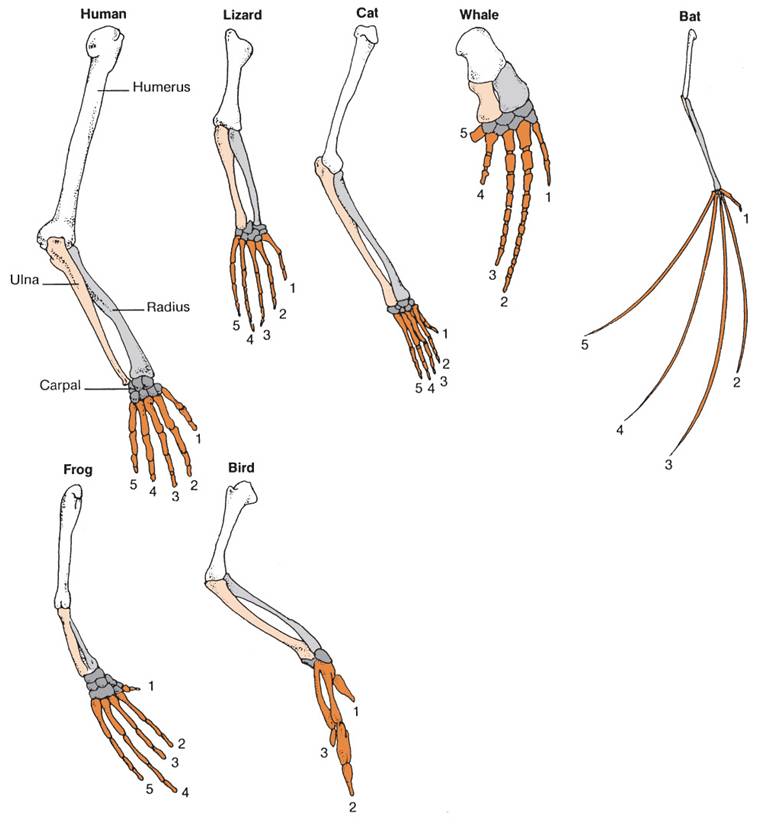 C.
Allometry
C.
AllometryWhen we look at the diversity within a group of similar animals, what we usually see are changes in the proportion of different body parts - not really changes in the the types of parts, themselves. So, in mammals, we see the same skeletal system; the differences between mice and bats is not really in the types of bones they have, but rather in the relative sizes of the bones. So, the finger bones in a bat wing are long relative to the limb bones; whereas in mice, the finger bones are short relative to the limb bones. These differences occur because of the differences in the rates of growth of these bones during embryogenesis, and they are caused by changes in the activity of developmental genes. These changes in the relative growth of different body parts is called allometry. When we look at any large group or organisms - such as the insects or the vertebrates, what we see are differences on a single body theme - differences in shape due to relative differences in the sizes of the body parts. We now know that these differences in size, so important to creating the diversity of species that we see within a group - are largely do to differences in development. Again, the most remarkable discovery in evolutionary biology over the last 30 years is the discovery that differences between large groups of organisms - like the differences between insects and vertebrates - occurs despite an extraordinary similarity in the developmental processes and developmental genes that regulate their development.
Likewise, homologous structures in a large group of organisms, like limbs in terrestrial vertebrates, are NOT the result of changes in structural genes. These structures are built out of the same material. Rather, the differences in the relative proportions of these bones is due to differences in developmental genes that alter the relative growth rates of the bones in the limbs and digits. Of course, the changes in the frequencies of these genes can be affected by our five agents of evolutionary change. In particular, as we saw with finch beaks, these changes in the proportions of body parts can be as adaptive as the genes for structural proteins like flower color. So, although the modern synthesis described a model of microevolutionary changes in structural genes within a population, the elucidation of developmental genes that influence to large scale structure of body plans allowed evolutionary biology to explain changes in body plan with the same model - but as a change in the gene frequencies of different genes - the genes that influence the process and pattern of development, itself. So, 'macroevolutionary' differences are the result of 'microevolutionary' processes occurring in developmental genes; 'macroevolution' and 'microevolution' are not two different things.
For another example, consider one genus of Scarab beetles, the genus Onthophagus. The different beetle species in this genus have a wide variety of horn shapes and sizes; the males use the horns to battle for mates (intrasexual selection), and they may also be under some control by intersexual selection (preference of females for males with a particular horn shape). If the ratio of horn size to body size is calculated for many individuals within these species, the species cluster in a manner consistent with their hypothesized phylogenetic relationships. So, it would seem that allometric growth in horn size has been an important factor correlating with divergence in this genus.
And, for yet another example, consider the evolutionary relationships between lobe-finned fishes and amphibians. There is now a very nice sequence of intermediate fossils of transitional proto-amphibians in the fossil record. When the structure of the bones in lobe-finned fishes, transitional fossils, and amphibians is examined, the changes are not in the presence of new bones, but rather in the spatial relationships, relative sizes, and developmental patterning of limb architecture. These changes were probably driven by changes in regulatory genes and transcription foactors.
 |
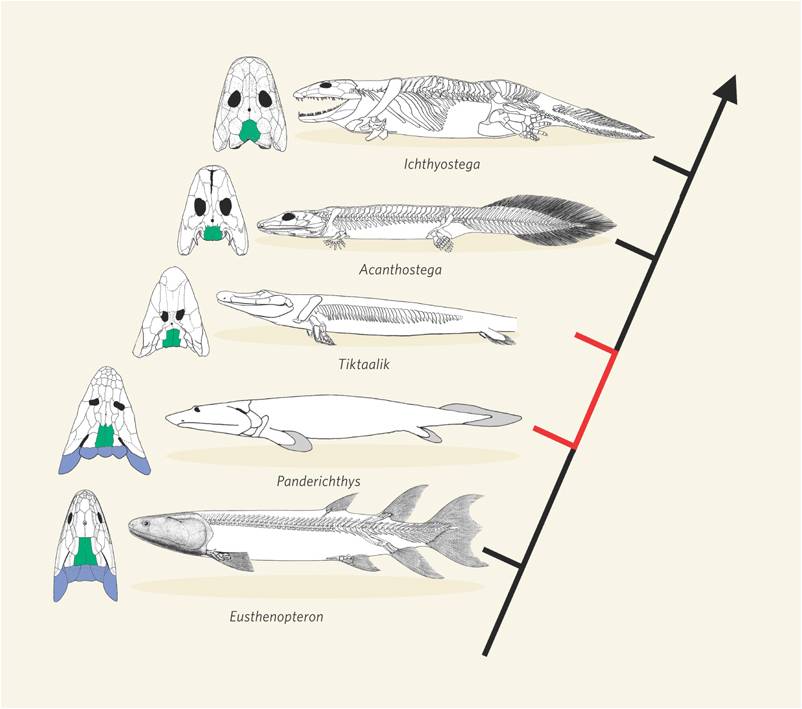 |
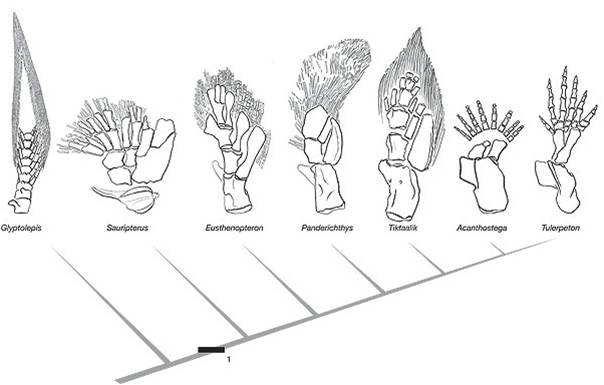 |
| The limb bones in lobe finned fishes and terrestrial vertebrates are homologous. | The transition from fish to terrestrial amphibians is well documented in the fossil record | The change in forelimb structure is really one of a change in the relative position of skeletal units and skeletal architecture. |
 Large
scale differences in morphology that define the major groups of organisms -
which are sometimes refered to as "macroevolutionary" patterns - are
probably not caused by changes in structural genes. However, this does not mean
that these changes are orchestrated by different processes. Rather, these macroevolutionary
changes that occur in large-scale morphological characteristics are probably
caused by changes in the action of regulatory genes like transcription factors,
which affect developmental processes. The changes in the action of these genes
can be modeled by population genetics, too; and we would expect the effects
of the genes to be acted on by natural selection, genetic drift, positive assortative
mating, mutation, and migration. So, in this sense, microevolutionary changes
that occur within a population at a given locus can cause the macroevolutionary
patterns that we see in the evolution of new, different types of organisms.
It just that those microevolutionary changes in gene frequencies are occurring
at the loci of regulatory genes that co-ordinate morphological development in
that population.
Large
scale differences in morphology that define the major groups of organisms -
which are sometimes refered to as "macroevolutionary" patterns - are
probably not caused by changes in structural genes. However, this does not mean
that these changes are orchestrated by different processes. Rather, these macroevolutionary
changes that occur in large-scale morphological characteristics are probably
caused by changes in the action of regulatory genes like transcription factors,
which affect developmental processes. The changes in the action of these genes
can be modeled by population genetics, too; and we would expect the effects
of the genes to be acted on by natural selection, genetic drift, positive assortative
mating, mutation, and migration. So, in this sense, microevolutionary changes
that occur within a population at a given locus can cause the macroevolutionary
patterns that we see in the evolution of new, different types of organisms.
It just that those microevolutionary changes in gene frequencies are occurring
at the loci of regulatory genes that co-ordinate morphological development in
that population.
One of Darwin's principle contributions is the theory of common ancestry - the theory that species are biologically related to one another and are descended from shared ("common" meant as "in common") ancestral species. Darwin's other major contribution - natural selection - describes how this process of divergence might take place: as a consequence of populations adapting to different environments and becoming different from one another. Of course, as Darwin realized, these changes must be heritable - or genetic. We now know that there are a variety of other agents of evolutionary change that can cause change in the genetic structure of a population. All of these changes can, in principle, create enough genetic divergence between populations to render mating, fusion of gametes, or correct development of offspring unlikely. When this occurs, the two populations have achieved "reproductive isolation" - the inability to mate and produce offspring with members of another group. In a genetic sense, this is what we mean by the term 'species'. Although there are situations where this definition is problematic (see below), there is a biological realism to this definition for sexually reproducing organisms. Populations that become reproductive isolated from other groups have a unique biological and genetic identity. Their gene pool is now independent of other genes pools, and changes that occur in this gene pool will be unique (even just by chance genetic drift) and will make this population even more different from other groups. In other words, once a population is reproductively isolated from other groups, it will tend to become even more genetically different and biologically unique.
Ernst Mayr, one of the principal authors of the modern synthetic theory and one of the most prominent evolutionary biologists of the 20th century, created the 'biological species concept' in the 1940's. As described above, Mayr defined a species as "a group of organisms that mate among themselves and are reproductively isolated from other such groups." Although this is a biologically attractive definition (because we are trying to identify biological units that differ, and if they don't breed then they do or will differ, genetically), there are some real problems that can occur.
- for many species (fossils and living) the reproductive biology is not described. How shall we classify these organisms?
- for asexual species, reproductive isolation occurs at the clone level...is each clone a species?
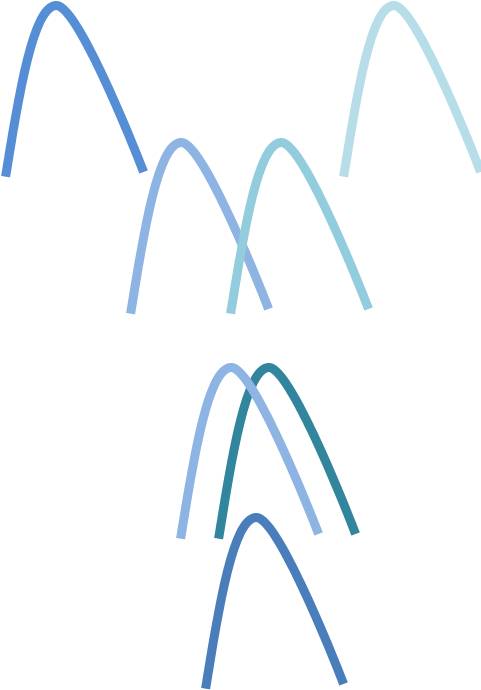 -
finally, we cannot simply use genetic differences as a determinant. Although
reproductive isolation and biological uniqueness correlates with genetic difference,
sometimes single genes can cause populations to become reproductively isolated.
In other cases, genes are transferred laterally - between unrelated organisms
by viruses - and so genetic similarity at a given locus may not indicate recent
ancestry. Indeed, horizontal gene transfer may be so common in prokaryotes that
a pattern of divergence (family 'tree') may be impossible to recreate and may
not be the correct representation of evolutionary relationships, anyway. In
other words, if a lineage receives 30% of its genes from organisms that it is
not decended from, then is "descent with modification" and common
ancestry the most correct and useful and predictive model to describe the evolution
of this group?
-
finally, we cannot simply use genetic differences as a determinant. Although
reproductive isolation and biological uniqueness correlates with genetic difference,
sometimes single genes can cause populations to become reproductively isolated.
In other cases, genes are transferred laterally - between unrelated organisms
by viruses - and so genetic similarity at a given locus may not indicate recent
ancestry. Indeed, horizontal gene transfer may be so common in prokaryotes that
a pattern of divergence (family 'tree') may be impossible to recreate and may
not be the correct representation of evolutionary relationships, anyway. In
other words, if a lineage receives 30% of its genes from organisms that it is
not decended from, then is "descent with modification" and common
ancestry the most correct and useful and predictive model to describe the evolution
of this group?
4. The issue:
The problem of classifying species is caused, in part, with the very process of speciation. Even in a classic case of two isolated populations diverging genetically, this process of genetic divergence may be continuousover timeor space; making the assignment of categorical distinctions problematic. When (or whre across the range) in this continuous process should they be called different species? To name a species is to create a discrete group; however, all biological groups may not be discrete - they may still exhibit some continuous variation with another group - even to the point that they still reproduce at some level (hybridization). This is simply a consequence of how speciation occurs and which genetic differences have occurred.
Well, that obviously depends on how you are classifying them! However, we will proceed with the rest of this lecture applying the biological species concept of Mayr. So, the question changes from 'how does speciation occur?' to 'how does reproductive isolation occur?' Over the years, several 'reproductive isolating mechanisms' have been identified. Typically, these are divided into factors that act before (pre-zygotic) or after (post-zygotic) the formation of a zygote.
1. Pre-zygotic Isolating Mechanisms: What could prevent two populations from mating and forming a zygote?
- Geographic isolation: they are in different places and so do not reproduce. Tigers and lions now have ranges that do not overlap, and so they do not mate in nature - even though they will mate in captivity. For 99.999% of biologists, lions and tigers are still 'good' species.
- Temporal isolation: they are in the same place, but they are active or breed at different times of day or year. Many closely related insects have adapted to different temperature environments, or different host plants that are available at different times, and so they breed a few weeks apart and are reproductively isolated.
- Behavioral isolation: they live in the same place and breed at the same time, but do not recognize one another as suitable mates. Many waterfowl may mate at the same time in the same mating grounds, but they have very elaborate and species-specific courtship rituals that reduce the likelihood of interspecific mating.
- Mechanical isolation: they attempt to mate with each other but their genitalia do not fit. For arthropods with 'lock-and-key' copulatory organs, small changes in the shapes of the organs may result in reproductive isolation.
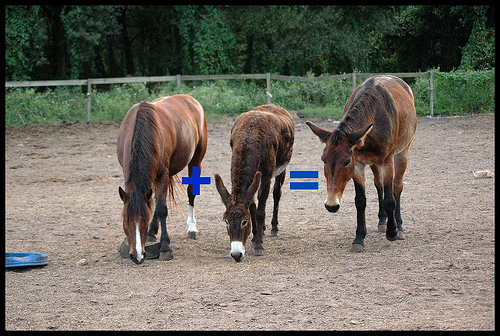 -
Chemical isolation: the sperm may not tolerate the chemical environment of the
female reproductve tract. Chemical isolation is also common in plants, where
the pollen must digest a pollen tube through the style to reach the ovule and
egg. Chemical incompatibility can result when the pollen does not have the correct
digestive enzymes.
-
Chemical isolation: the sperm may not tolerate the chemical environment of the
female reproductve tract. Chemical isolation is also common in plants, where
the pollen must digest a pollen tube through the style to reach the ovule and
egg. Chemical incompatibility can result when the pollen does not have the correct
digestive enzymes.
2. Post-Zygotic Isolating Mechanisms: What cound prevent the zygote from establishing a new population or transferring genes between populations?
- Genomic incompatibility: The zygote forms but the genomes are too different to orchestrate a coordinated development. No embryonic development or incorrect development occurs and no offspring is produced.
- Hybrid sterility: an offspring is produced, but because the chromosomes are not homologous, sexual reproduction is impossible and the hybrid is sterile. So, the two populations can get genes to combine, but they cannot get genes from one population into the other - just into the hybrid. So, the populations are still gnetically isolated from one another. (Donkeys and horses mate to make sterile mules).
- Low hybrid fitness: The hybrid can reproduce, but does so at a lower level than members of the original populations. In this case, the hybrid may be able to transfer genes between populations, but the frequency of hybrids will remain low as they are selected against. Many plants show this pattern. There are many oaks such as Northern red oak, scarlet oak, and southern red oak that hybridize.
Recognizing that natural selection and genetic drift were the two primary agents of evolutionary change, Ernst Mayr suggested that evolution would be particularly rapid when both of these agents were acting together - such as when small populations became isolated in a new environment. He thought that this would be happening quite frequently along the periphery of a species' geographical range, with small number of colonists becoming isolated from their ancestral populations in new habitats where they would be subject to new selective forces. He called this type of speciation "peripatric speciation".
In the 1970's, Stephen J. Gould and Niles Eldridge were paleontologists at the American Museum of Natural History. They were familiar with the inconsistency between Darwinian selection, which was often portrayed as a gradual, 'uniformitarian' process, and the pace of change in the fossil record. Although many lineages showed the type of gradual change that Darwin described, other lineages showed something quite different - long periods of morphological stasis interrupted by rapid periods of change. In short, they considered Darwin's last outstanding dilemma - why did the fossil record appear discontinuous, even where there were identified intermediates? In other words, even for lineages where intermediates were found, some species showed long periods of duration and others, seemingly associated with bursts of evolutionary radiations, appeared for a short time in local areas. Eldridge and Gould called this pattern 'punctuated equilibrium', suggesting that the typical lineage consisted of species that maintained long periods of morphological stasis (equilibrium) that were punctuated by rapid change. Changes were followed by descendant species that maintained their morphology unchanged for another long period.
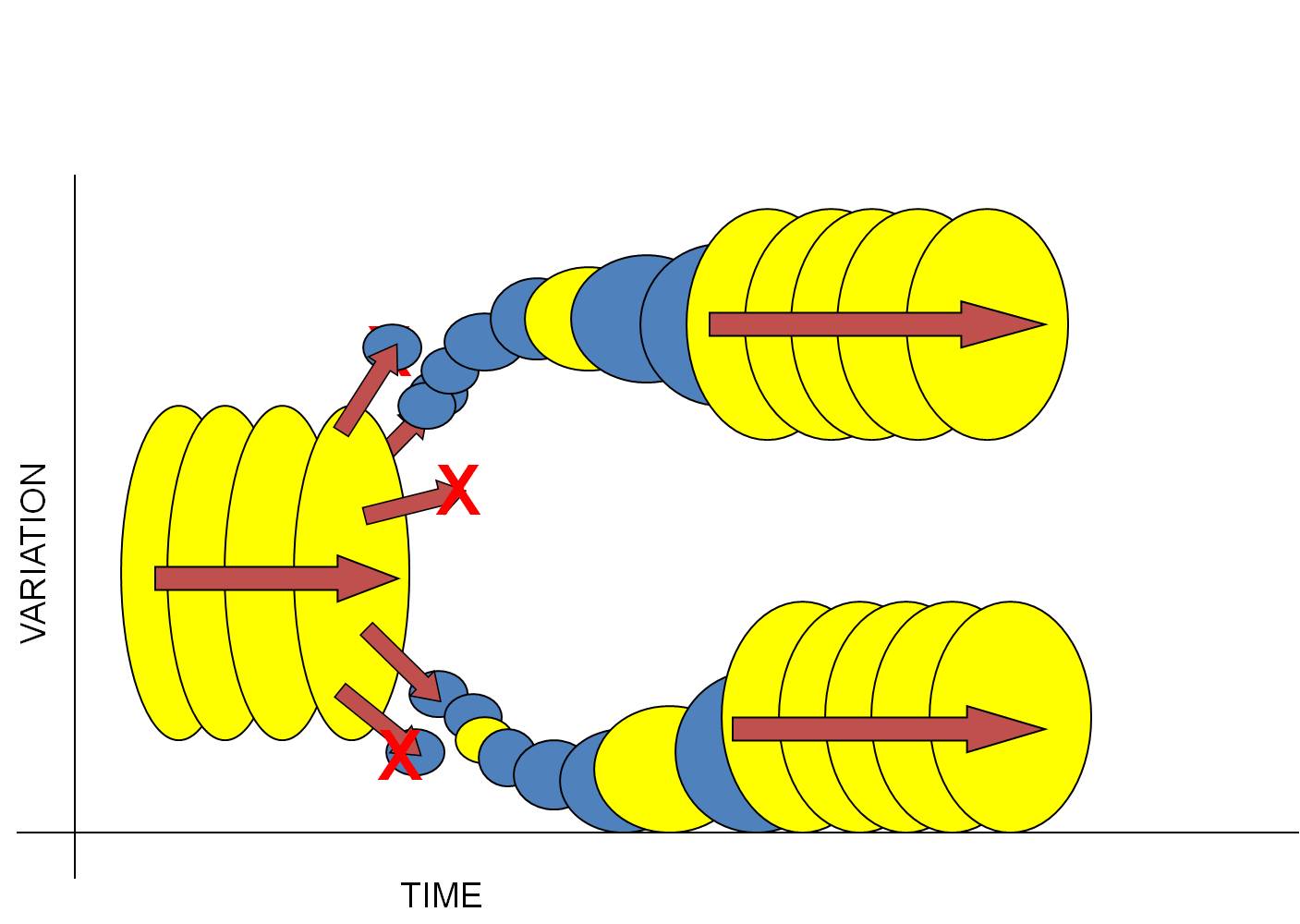 C.
A Resolution
C.
A ResolutionIf Mayr was correct in concluding that most evolutionary change should occur in small, isolated populations, then the discontinuous, punctuated pattern described by Eldridge and Gould naturally follows. Consider the following scenario:
1) Consider a large, well-adapted population. Indeed, these two characteristics often go hand in hand. "Well-adapted" means that the species is able to efficiently harvest energy from the environment and convert it effectively into offspring. So, large populations that reproduce successfully should be well adapted to their environment. And as long as the environment remains stable, then the effects of selection should be weak... most organisms have an adaptive genotype and there is little differential reproductive success among them. Likewise, if the population is large, then the effects of drift are small. So, a large, well-adapted population should change little over time (equilibrium). This is represented by the large yellow circles to the lef - the ancestral species - changing little over time.
2) Now insert Mayr's concept of peripatric speciation. Large populations often have a large geographical range. And if small populations 'bud-off' this large range into new habitats, then both drift (small populations of colonists) and natural selection (new habitat) will probably either change the genetic structure of the population rapidly, or cause the extinction of the population (because the narrow range of genetic variation contained in the small population of colonists is unable to tolerate the environmental conditions in the new habitat). This is represented by the small blue circles budding off last large yellow one.
3) So, most subpopulations colonizing new habitats will go extinct (this may be why the population didn't live there, in the first place). But occasionally, a small, genetically different subset may be able to tolerate the conditions in a new environment and persist. It will adapt rapidly to these new conditions, changing (evolving) rapidly as a consequence of drift and selection. These ideas are represented by some blue populations going extinct (red X), and others changing rapidly - a steep slope in variation over time.
4) Over these generations, when the population is small and changing in response to the environment, it is unlikely that each 'step' or 'transitional species' in this sequence will preserve a fossil. The populations are small (so it is unlikely that the rare event of fossilization will preserve a member of the species), and each morphologically distinct population is also short-lived; this will also reduce the chances that a member of the population gets fossilized (before it has evolved again). So, these small, rapidly changing populations are unlikely to each leave a fossil - and unfortunately, this may be just where the most evolutionary change is occuring in the lineage. (Yellow circles, both large and small, are the populations that leave a fossil.)
5) Now, as a population adapts to its new habitat, it should (almost by definition) become more effective at converting energy from the environment into successfully reproducing offspring. After all, this is what natural selection does - it increases the reproductive success of the population. So, as a population adapts to the environment, it should increase in size, too.
6) So, the population is becoming larger and better adapted to the environment. So, the effects of selection and drift should decline, and the rate of change should slow. Eventually, we have another species that is large and well-adapted to its environment, changing little over time. (The sequence of large yellow circles at the right of the figure).
This model of evolution explains Darwin's last dilemma - the apparent discontinuity of the fossil record. A modern understanding of evolution, that appreciates the effects of selection and drift acting on structural and regulatory genes, will cause rapid change in small populations and little change in well-adapted populations. Because fossilization is a rare event, small, short-lived populations will be far less likely to leave a fossil than a large, long-lived population. For this reason, because speciation is concentrated in local populations changing quickly, the fossil record will appear discontinuous. Rather than "explaining away" this discontinuity, Eldridge and Gould explained it as a necessary consequence of a modern understanding of the pattern and process of evolution.
Study Questions:
1. What are homeotic genes, and what type of protein do they code for?
2. Explain homologous structures in terms of the regulation of developmental genes.
3. State the 'biological species concept'. Why is reproductive isolation such a good biological benchmark for defining biologically--genetically--different groups?
4. Describe three reasons why two populations might not breed together.
5. Use the concepts of peripatric speciation and punctuated equilibrium to explain why we don't have complete sequences of fossils that preserve every morphological change that occurs in a lineage.